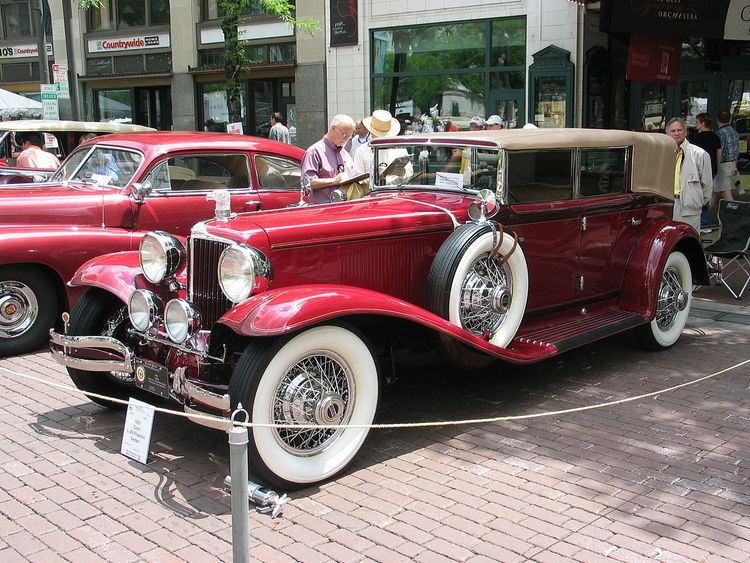 | ||
Cord was the brand name of an American automobile company from Connersville, Indiana, manufactured by the Auburn Automobile Company from 1929 to 1932 and again in 1936 and 1937.
Contents
The Cord Corporation was founded and run by E. L. Cord as a holding company for his many transportation interests, including Auburn. Cord was noted for its innovative technology and streamlined designs. Cord had a philosophy to build truly different, innovative cars, believing they would also sell well and turn a profit. This did not always work well in practice.
Innovations
Cord innovations include front-wheel drive on the L-29 and hidden headlamps on the 810 and 812.
Hidden headlamps did not become common as a standard feature until the 1960s (though DeSoto used them in 1942). The early Oldsmobile Toronados, whose GM stylists later stated they were trying to capture the "feel" of the Cord's design, also featured hidden headlamps.
"Servo" shifting was accomplished through a bendix electro-vacuum pre-selector mechanism (a type of electromechanical shifting).
Cord L-29
This was the first American front-wheel drive car to be offered to the public, beating the Ruxton automobile by several months, in 1929. The brainchild of former Miller engineer Carl Van Ranst, its drive system borrowed from the Indianapolis 500-dominating racers, using the same de Dion layout and inboard brakes. This allowed it to be much lower than competing cars. Both stock cars and special bodies built on the Cord chassis by American and European coachbuilders won prizes in contests worldwide. The L-29 came with full instrumentation, including a temperature gauge, oil pressure gauge, and speedometer on the left with a gas gauge, oil level gauge, and Ammeter on the right of the steering wheel.
It was powered by Auburn's 4,934 cc (301 cu in) 125 hp (93 kW) L-head Lycoming inline 8 from the Auburn 120, with the crankshaft pushed out through the front of the block and the flywheel mounted there, driving a three-speed transmission. Gearing in both transmission and front axle was inadequate, and the 4,700 lb (2,100 kg) car was underpowered, limited to a trifle over 80 mph (130 km/h), inadequate even at the time, and readily exceeded by the less expensive Auburn. Still, the styling was lovely, and despite the 137.5 in (3,490 mm) wheelbase and steering demanding fully four turns lock-to-lock, handling was reportedly superb. Priced around US$3,000, it was competitive with Cadillac, Marmon, Lincoln, Packard, Franklin, and Stutz; the 1930 Chrysler copied several styling elements. It could not outrun the Great Depression, and by 1932, it was discontinued, with just 4,400 sold. Wheelbase was 137.5" and the height of the sedan was 61".
Cord Model 810/812
The Model 810/812 are probably the best-known of the company's products. Styled by Gordon M. Buehrig, they featured front-wheel drive and independent front suspension; the front drive enabled the 810 to be so low, running boards were unnecessary. Powered by a 4,739 cc (289 cu in) Lycoming V8 of the same 125 hp (93 kW) horsepower as the L-29, the 810 had a four-speed electrically-selected semi-automatic transmission, among other innovative features.
The car caused a sensation at the New York Auto Show in November 1935. Orders were taken at the show with Cord promising Christmas delivery, expecting production of 1,000 per month. Production delays pushed the expected delivery date to February 1936. This proved optimistic; the first production vehicles were not delivered until April. In all, Cord managed to sell only 1,174 of the new 810 in its first model year. The car is well known for the flat front nose with a louvered grille design. The front was so similar in look to a coffin, the car was often called "Coffin Nose".
Demise of the Cord
Early reliability problems, including slipping out of gear and vapor lock, cooled initial enthusiasm, and the dealer base shrank rapidly. Unsold left-over and in-process 1936 810s were re-numbered and sold as 1937 812s. In 1937, Auburn ceased production of the Cord. A single 1938 Cord prototype with some changes to the grille and transmission cover was built, and it still exists (2015). The Cord empire, amid allegations of financial fraud, was sold to the Aviation Corporation, and E.L. Cord moved to Nevada where he earned millions in real estate and other enterprises.
Revival
The Cord 812 design was re-marketed almost immediately in 1940, as ailing automakers Hupmobile and Graham-Paige tried to save money, and revive the companies, by using the same body dies. Except for their similarity to the 810, their four-door sedans, the Hupp Skylark and the Graham Hollywood, were unremarkable. Retractable headlights gave way to plain headlight pods, and power came from a standard front-engine/rear-wheel drive design. While Hupp Motor Company built a few prototypes in 1939 that gained them sales orders for the 1939 model year they did not have the resources to manufacture the car. Graham Paige stepped in offering to build the Hupmobile Skylarks on a per piece contract basis. Graham built a combined 1850 units for sale in the 1940 model year. Hupmobile closed before the 1941 model came around. Of the 1850 cars produced in the 1940 model year by Graham only about 450 were the Hupmobile Skylarks. Graham continued to build the Hollywood late into 1941. They stopped production in November of that year having only built a rumored 400 units. The Hollywood was powered by a supercharged Continental in line six making 124 HP, almost 50 less than the original supercharged Cord.
